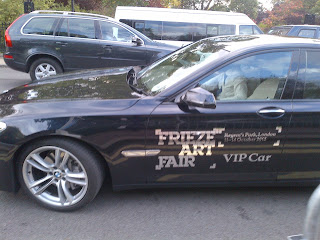Today I have visited an amazing event in London called „the frieze art fair“ and „the frieze masters“. The Frieze art fair is a fair in Regent‘s Park in London which has been going on for four days in October and presented 175 of the world‘s leading contemporary art galleries (Frieze London, 2012). The Frieze Masters, which was located within walking distance of the frieze art fair presented over 90 of the world‘s leading galleries, displaying art from ancient to modern times (Frieze Masters, 2012).
The reason I chose to write about this event is, that I have realized how important art is for the world of luxury brands as well as for the target customer of many luxury brands. Furthermore in my opinion art itself as well as buying and possessing arts has become a luxury.
When you look at the prices for modern as well as ancient art it becomes obvious that people buying art are people that have a high spending power. Furthermore most of them also buy art not only because it is nice and they are interested in arts but also as an investment.
Therefore by taking into consideration their spending power and their affectation for beautiful products one could assume that many of those people are also interested in buying other luxury products such as luxury fashion, cars, jewellery or services.
My research today has shown that a lot of the people visiting both art fairs do wear many status symbols and famous brands. Interestingly enough there was a distinction between the frieze art fair and the frieze masters exhibition as people at the frieze master seemed to be more concerned about understatement and class than people at the London frieze. This also proofs what I have mentioned earlier about different groups of luxury customers. Whereas many people at Frieze art were wearing Louis Vuitton bags, Alexander McQueens pieces and other very eye-catching and fashionable fashion items, people at frieze masters were wearing less in-your-face brands but remarkable good quality clothes such as cashmere coats, silk scarves and items from brands like Hermes and Louboutin (von Flotow, 2012).
What is thought was interesting as well, was the list of sponsors which included Deutsche Bank, COS, BMW, ArtFund, Pommery, Hyatt Regency London, Simmons&Simmons, The Royal Parks and James Cooper Speciality Papers.
Source: von Flotow (2012)
Deutsche Bank, as the main sponsor, for example invited a selection of their customers to the event and also offered food and drinks for them in an extra tent. Furthermore there were certain VIP services, which were sponsored and carried out by companies such as BMW, who offered a VIP Shuttle, Quintessentialy, Illy and many more as you can see in the picture below (von Flotow, 2012). The Financial Times, as their media partner, offered free issues of their weekend newspaper, accompanied with a copy of their magazine "how to spend it", which targets high network individuals, hence people with “investable
assets of more than $1m excluding primary residence” (Thomas, 2008).
Moreover both locations were equipped with different cafes and restaurants, all of them very posh and trendy. There was for example a champagne bar, a British artisan bakery, a Japanese sushi restaurant and a pizza bar (von Flotow, 2012). So even here instead of having cafeterias offering sandwiches and fast food as in many museums the target customer's desires were perfectly fulfilled by offering high standard and quality food and drinks in a nice atmosphere.
But although today I have clearly realized that this exhibition targeted a very similar audience to many luxury brands, I also realized again that some artists or galleries are luxury brands themselves.
If you look at Damien Hirst for example, whose art pieces have been displayed in an amazing exhibition at Tate Modern earlier this year, one can say that he has managed to be recognised as a brand himself. Although he is seen controversial, his name is famous in the world of arts and through his name alone his art pieces sell for enormous sums.
If you look at Damien Hirst for example, whose art pieces have been displayed in an amazing exhibition at Tate Modern earlier this year, one can say that he has managed to be recognised as a brand himself. Although he is seen controversial, his name is famous in the world of arts and through his name alone his art pieces sell for enormous sums.
But also if you look at art galleries such as Saatchi Gallery, London or auction houses such as Sotheby‘s or Christie‘s in the world of arts their names are equivalent to luxury brands.
 | ||||||||
| http://rhinoreach.files.wordpress.com/2010/04/saatchigallery0011.jpg |
References:
Frieze London (2012). Frieze Art Fair.
Available at: http://friezelondon.com/ (Accessed 12.10.2012).
Frieze Masters (2012). Frieze Masters.
Available at: http://friezemasters.com/ (Accessed 12.10.2012).
Frieze London (2012). Frieze Art Fair.
Available at: http://friezelondon.com/ (Accessed 12.10.2012).
Frieze Masters (2012). Frieze Masters.
Available at: http://friezemasters.com/ (Accessed 12.10.2012).
Thomas,
D. (2008). World’s rich
shrug off credit crunch.
Available at: http://www.ft.com/cms/s/0/22d7b1aa-0eee-11dd-9646-0000779fd2ac.html#axzz2DixfJhOD (Accessed: 21.11.2012).
von Flotow, Katinka (2012). Images Frieze 14.10.2012. London: Regent's Park.






Keine Kommentare:
Kommentar veröffentlichen